2020 Santa Cruz Hightower
Test Location: Gunnison-Crested Butte Valley, Colorado
Duration of Test: ~6 months
Size Tested: Large
Geometry: See Below
Build Overview (S / Carbon C / 29 Build Kit):
- Drivetrain: Sram GX Eagle
- Brakes: Sram Code R
- Fork: RockShox Lyrik Select+
- Rear Shock: RockShox Super Deluxe Select+ Air
- Wheels: Race Face AR Offset 30/DT 370 Wheelset
Wheel Size: 29′′
Travel: 140 mm rear / 150 mm front
Blister’s Measured Weight: 32.01 lbs without pedals
MSRP (as built): $5199 USD
Reviewers:
- Eric Freson: 5’10”, 165 lbs; Ape Index +1.5; Inseam 31″
- Dylan Wood: 5’11”, 155 lbs; Ape Index +0.5; Inseam 32”
- Jonathan Ellsworth: 5’10”, 175 lbs; Ape Index +1.0; Inseam 30”

Intro
The redesigned Santa Cruz Hightower is intended to sit in what SC calls the “Goldilocks zone” of mountain bikes. With 140 mm of rear travel, 29” wheels, and modern geometry, it’s supposed to be good at a lot of mountain-bikey things, with minimal compromises on the up or down.
Of course, just about every brand says the same thing about their bikes in this travel class. So last fall and this spring, three of us have been riding the Hightower all over Gunnison and Crested Butte (and Moab and Buena Vista) to see where the Hightower actually fits into the big category of do-everything bikes.
First we’ll dive into the specs, geometry, and build of the Hightower., then I, Dylan Wood, and Jonathan Ellsworth will each chime in about its on-trail performance.
Past & Current Versions: “v1 Hightower” vs. “v2 Hightower”
Some quick clarification: the first version of the Hightower, which we’ll just call the “v1 Hightower” and that Noah Bodman reviewed, was released for the model year 2016. The current Hightower that we’re reviewing here was first released for the model year 2020, and we’ll call it the “v2 Hightower.” There are a lot of notable differences between the two versions, so let’s dive in:
The Frame
As with all of Santa Cruz’s full-suspension bikes, the Hightower uses their VPP (“Virtual Pivot Point”) suspension design. And like the majority of their recently revised models, the v2 Hightower now features the lower-link-driven version of VPP. All versions of the v2 Hightower offer 140 mm of rear-wheel travel, and the complete Hightower builds come with 150mm-travel forks.

You can get a Hightower with an aluminum or carbon frame, but there are two subtly different carbon versions — the Carbon C and Carbon CC. The C is spec’d on the more budget-oriented builds while the CC is used on higher-end ones. If you want the frame only, you can pick from aluminum or Carbon CC.
The difference between the two carbon frames is in the carbon layup, with the CC version cutting a modest amount of weight (Santa Cruz claims ~280 grams depending on model & size), allegedly at no loss of stiffness or strength.
Santa Cruz doesn’t list a weight for the aluminum frame itself, but FWIW, the aluminum version of the “S” build is reportedly 1.13 kg / 2.49 lbs heavier vs. the Carbon C version of the “S” build (which is the build we’ve been riding).
As we just noted, the v2 Hightower drives its rear shock via the lower link. In addition to the lower location of the shock, this design change produces a much more progressive leverage curve compared to most of Santa Cruz’s Trail and Enduro bikes of old. While Santa Cruz still says the v2 Hightower’s leverage curve is “nearly linear,” it does not feature the digressive section in the first half of the travel that those older VPP bikes had. These are changes that should (and, spoiler alert, do) make it more supportive through the mid-stroke vs. the older VPP designs. It’s also worth noting that Santa Cruz does not recommend coil shocks with the v2 Hightower, and they also say it is not compatible with the Fox Float X2 or Cane Creek DB Air shocks.
The Hightower routes all three cables internally, features a threaded bottom bracket shell, and space in the front triangle for a water bottle. Befitting a modern mountain bike, there’s no provision for a front derailleur, but Santa Cruz did include ISCG ‘05 tabs for a chain guide.
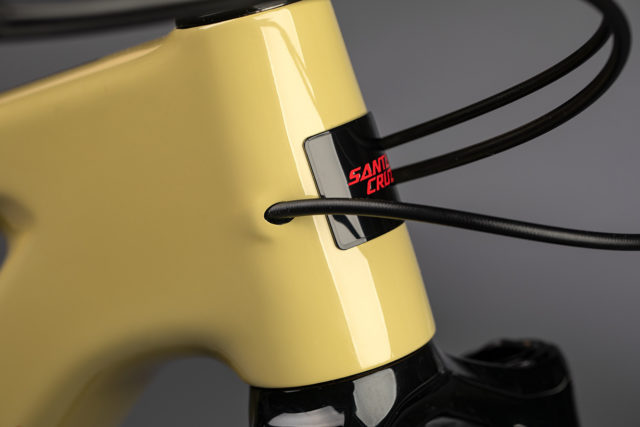
Warranty
As with all current Santa Cruz frames, the Hightower frame and bearings have a lifetime warranty against manufacturing defects for the original owner, and replacement parts are available at a reduced cost in the event of non-warranty-covered damage.
The Build
The Hightower is offered in a lot of different builds, and they span a broad price range.
At the lower end, there’s the “D / Aluminum” spec with a Sram SX Eagle drivetrain, RockShox 35 Gold RL fork, and Fox Float Performance DPS shock for $2,899.
At the very upper end, there’s the “XX1 AXS Reserve / Carbon CC” build with a RockShox Lyrik Ultimate fork, RockShox Super Deluxe Ultimate rear shock, and Santa Cruz Reserve Carbon wheels that will set you back $10,499.
In between those ends of the spectrum, there are six other builds. The Hightower frame is also available in both Aluminum or CC Carbon for $1999 or $3299, respectively.
Every full-bike build for the Hightower comes with 2.4″ Maxxis Minion DHR2 3C EXO TR tires front and rear, and all apart from the D and R builds get a RockShox Reverb Stealth dropper (the D and R builds get a Race Face Aeffect dropper).
You can also upgrade to Santa Cruz’s carbon Reserve wheels on the S / Carbon C and X01 / Carbon CC builds for an extra $1200.
We’ve been riding the “S / Carbon C” build, and some of its key components are listed below. For more details on the build kits offered for the Hightower and every current Santa Cruz mountain bike, check out our Santa Cruz Brand Guide.
Hightower S / Carbon C Build:
- Drivetrain: SRAM GX Eagle
- Brakes: SRAM Code R
- Fork: RockShox Lyrik Select+
- Rear Shock: RockShox Super Deluxe Select+ Air
- Wheels: Race Face AR Offset 30/DT 370 Wheelset
Thoughts on the Build
Eric Freson: Overall, the Hightower S / Carbon C build and I have gotten along really well. I think it’s a practical mix of components that you are unlikely to break, that will be able to handle most riding quite well, and that won’t completely crush your wallet.
The Reverb dropper still feels great and is quick to extend, the GX drivetrain is shifting smoothly, and the Lyrik fork and Super Deluxe shock have been well composed without feeling overdamped.
In particular, I have really enjoyed the RockShox Lyrik Select+ and RockShox Super Deluxe Select+ setup on the Hightower S / Carbon C build. I would add a volume spacer or two to the shock if this were my personal bike to keep from more-frequent-than-desired bottom-outs, but I was impressed by the very supple feel off the top of both the fork and shock’s initial stroke / travel.
The only component choice I was really on the fence about was the choice to spec a Maxxis Minion DHR2 on the back of the bike. But that’s very much a personal preference, and not an objective complaint about the tire’s performance in its intended conditions.
Personally, I would probably choose to run on the rear something a bit faster rolling and lighter than the DHR2. This is because the terrain I ride often rewards attacking out of the saddle and rarely offers tons of traction regardless of what tire I’m running, so I will generally take lower rolling resistance over all-out braking traction on my back tire.
The Hightower S / Carbon C’s aluminum bar, stem, and cranks also all performed well, but this is a bike where I noticed its weight on the trail from time to time. It’s not meant to be an XC-racer, KOM-crusher, but if this were my personal bike, I would likely spend a bit more in order to bring the weight down in an effort to help it excel even more on punchy climbs and just generally long days in the saddle.
In particular, the Hightower is a bike where I would be very tempted by the idea of upgrading to Santa Cruz’s carbon Reserve wheels (which I loved on the Megatower). As with the tires, my main reasoning would be to make the Hightower even quicker to spin up and move forward. The Hightower S / Carbon C’s component spec has performed right in alignment with its intent as an over-capable all-rounder that doesn’t cost an absolute fortune, but with how well it’s performed in that role, I think it’d be even better if it were a few lbs lighter.
Dylan Wood: I also think the Rock Shox Select+ suspension package felt great on the Hightower S / Carbon C. I am glad that Santa Cruz opted for a Lyrik up front instead of a Fox 36 Performance, which Eric and I both thought was a clear weakness of the Megatower’s S / Carbon C build kit. Like Eric, I would have preferred another volume spacer or two in the rear shock, but that is an easy fix that might not be necessary for every rider, depending on your riding style and terrain.
I’m pretty familiar with most of the components of the S / Carbon C build, and overall, I am still a fan of the performance you get for the money you spend. The SRAM GX Eagle drivetrain is still providing crisp shifting after some routine maintenance after ~5 months of riding (new chain, cable, and housing), and the RaceFace AR offset rims have stayed intact and true throughout many fast, rocky, and rooty descents. Personally, I enjoyed the Maxxis Minion DHR2 rear tire and this is likely because I spent more time on trails with more traction than Eric, where the DHR2’s great braking traction was noticeably better than a faster-rolling tire would’ve been.
I agree with Eric here that upgrading the rims to Santa Cruz’s Reserve Carbon wheels would be a great upgrade on this bike. Though they’re certainly an investment, the Reserve wheels could give this bike a snappier feel on the uphill and a little bit more of a composed and smooth feel on the way down. (I’ve spent a lot of time on the Reserve wheels on the Hightower LT and Megatower, and am a fan.)
With its somewhat middle-of-the-road 140 mm of rear travel, I think you could make some changes specifically in the tire and wheel department to make the Hightower more XC-oriented and efficient on the uphill. In contrast, you could also go the other direction and up the fork travel to 160 mm and put some bigger rotors on it for more of a downhill focus. Like most “Goldilocks” bikes in this class, there’s definitely room to slightly change the personality of the Hightower if you so desire. That said, we think a lot of people looking for a general, all-round Trail bike will get along quite well with the Hightower’s S / Carbon C build.
As for the SRAM Code R brakes, Eric had to bleed them twice and when I received the bike from Eric, it was quite clear that they needed another bleed. It turned out to be an issue with the brake lines, and after replacing those, the brakes have been working very well. For what it’s worth, the Code R brakes on the Megatower required a bleed early on, though, interestingly, the Code R brakes on the 2019 Specialized Enduro have been functioning flawlessly without a bleed for over a year.
Fit and Geometry
The Hightower is offered in five sizes, from Small through XXL, with reach numbers ranging from 425 mm to 518 mm. All feature a flip chip, which provides two different geometry settings. In the “Low” position, the Hightower has a 65.2° head tube angle and a 340 mm bottom bracket height. The change to the “High” position is subtle, bumping those numbers up to 65.5° and 344 mm, respectively. Interestingly, the XXL frame actually has a longer chainstay measurement than the other sizes, but that’s due to its different front triangle, not the rear triangle.
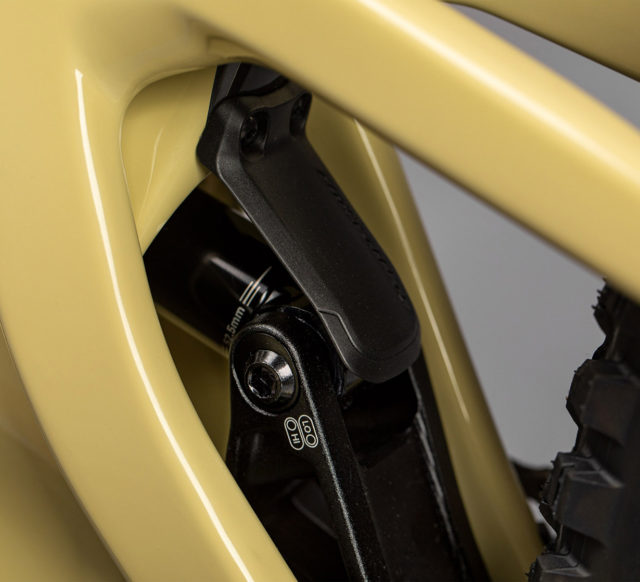
The Hightower’s effective seat tube angles vary slightly by size and which position you use for the flip chip, but they range from 76°–76.7° in the Low setting and 76.3°–77.1° in the High setting. (That’s the effective angle, with the actual angle being significantly slacker. Santa Cruz doesn’t publish a figure for the actual seat tube angle.)
Compared to the v1 Hightower, the new version’s geometry is significantly different. Comparing them in a size Large in the Low setting, the v2 Hightower’s head angle is 1.8° slacker, its seat tube angle is 2.2° steeper, and its reach is 20 mm longer. Overall, the v2 Hightower’s geometry is quite modern, and solidly within the norm for the latest class of ~140mm-travel 29ers.
We’ve been testing the size Large Hightower, and here are a few geo highlights for that size (in the Low position):
- 470 mm reach
- 65.2° head tube angle
- 76.5° effective seat tube angle
- 434 mm chainstays
- 1232 mm wheelbase
And here’s the Hightower’s entire geo chart for reference:
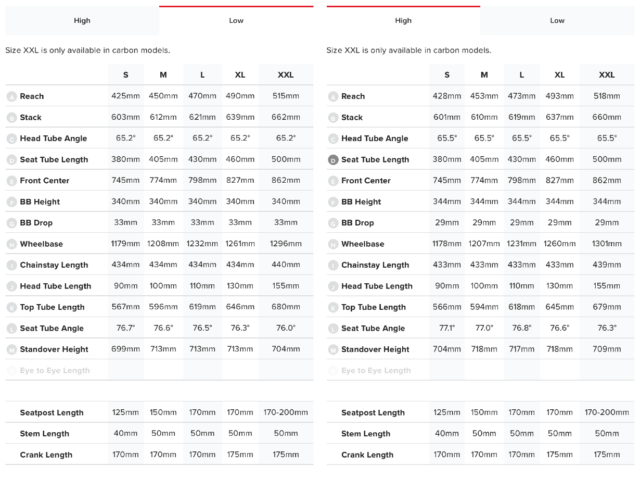
Thoughts on Sizing and Geometry
Eric (5’10”, 165 lbs): One of my favorite aspects of the Hightower is that, when you compare its geometry numbers to the 160mm-travel Santa Cruz Megatower, they are almost identical, apart from the differences in travel and head angle. In terms of geo, I think it’s fair to call the Hightower a “mini” Megatower, and this is really cool if you want a more moderate-travel, but very capable bike with “Enduroesque” geometry numbers. If you are looking for a very fast bike, but with a more nimble and quick feel compared to the longer-travel Enduro bikes of today, the Hightower should be on your radar.
So the Hightower, like the Megatower, is a big bike. With a reach of 470 mm and wheelbase of 1232 mm, the size Large Hightower is by a fair margin the longest bike in this travel class that I have spent a lot of time riding. As geo numbers keep growing and companies keep pushing the limits of that, I’d consider the Hightower to be quite progressive when you compare it against the current field of mainstream Trail bikes. There are some out there that are even longer and / or slacker, but the Hightower’s geometry looks far from dated right now.
While I’m on the shorter side (5’10”) of the Santa Cruz sizing chart for a Large Hightower frame, I’m still not interested in sizing down to a Medium. With its 50 mm stem and relatively short top tube (619 mm), I don’t have any issues with the fit of the Large. While climbing, my seated pedaling position is comfortable and at 5’10”, I don’t have the issue of over-extending the seat post and consequently putting my weight too far off the back. When standing and attacking out of the saddle, I have plenty of room to move about and get as far forward as I need.
While descending, I’ve enjoyed the size Large Hightower. I did initially have more trouble keeping weight (aka traction) over the front wheel of the bike compared to the Megatower, but this was more a result of the terrain where I was riding the Hightower, not as much as the bike itself. I noticed this on fairly mellow-gradient trails with ball-bearing-like granite over hardpack and flat corners that require a lot of precise body positioning in order to maintain grip. When the trails did turn steeper and it was easier to attack the fall line and the trail in a more neutral position on the bike, any issues I had with the front-end grip vanished. If you like going fast — even on a relatively mellow trail — there’s a good chance that you’re going to like the numbers of this Santa Cruz.
During my time on it, the Hightower has been living mostly in the Low geo setting since I was looking for as low of a center of gravity and as much initial traction as I could get on fast-but-very-loose springtime trails. The slightly lower bottom bracket and slightly more progressive leverage curve in the Low setting might have helped me maintain more traction. (Or that might have just been in my head.)
Dylan (5’11”, 155 lbs): Before riding the size Large Hightower, I had spent a lot of time on the size Large Megatower. Upon first throwing a leg over the Hightower, the fit felt very familiar, and it did give me the feeling of it being a mini Megatower. Once I looked at the actual geo numbers, I was happy (though not necessarily surprised) to find that the Hightower’s geo is extremely similar to the Megatower, with the most notable exception being the head angle (the Megatower’s head tube angle is 0.5º slacker).
So, the fit of the Hightower was really nothing new to me, and while I’m an inch taller than Eric, I agree with him in that I’ve found the size Large to feel comfortable and functional. I get what Eric is talking about when it comes to front-end traction on blown-out, sandy, flat corners, but it does take a true wizard to hit those sort of corners just right. I was fortunate to have the Hightower when many of Crested Butte’s more famous descents became dry and tacky, and did not have any issues with traction on either end of the bike.
I have also spent most of my time on the Hightower with it in the Low geometry setting. FWIW, Santa Cruz recommends starting with the Low setting and switching to High setting particularly if you are having issues with pedal strikes. Personally, I felt that the Low setting was most appropriate for the steep and fast terrain of Crested Butte classics like Doctor Park and Eccher Gulch. The low bottom bracket, slightly slacker head angle, and more progressive leverage curve all combined for a stable, supportive ride.
That said, even while riding the mellower, slower, but still technical trails of Hartman Rocks in Gunnison, I didn’t have much of an urge to switch the Hightower into the High position. Pedal strikes were never an issue for me, though I ride there a lot and have a good idea of where all the notorious SPD-smackers are at Hartman’s. But if you’ve got the opportunity, I’d recommend giving both settings a try. While the Hightower’s flip-chip isn’t practical enough to change mid-ride (most aren’t), it is fairly easy to switch between rides.
One thing I wish Santa Cruz would have done on the Hightower is integrate a chainstay-length adjustment flip-chip into the rear triangle of this bike. This is a feature that is present on Santa Cruz’s two other lower-link-driven 29” Trail / Enduro bikes, the Megatower and Tallboy, so it’s certainly possible. It’d be nice to be able to play with the chainstay length on the Hightower, though we’ve still been getting along just fine with it and its non-adjustable chainstays.
Jonathan Ellsworth (5’10”, 175 lbs): While I don’t normally weigh in on our bike reviews, we thought it would make sense for me to offer a couple quick thoughts on this one, first, because I’ve spent a lot of time on this bike, and second, because while I am far more charming, smarter, and clearly more humble than Eric and Dylan, they are faster riders than me, and are just generally better at bicycles than me (they both raced in college, while I was off playing football). So consider me as a representative of those who love riding while merely being okay / sorta decent / not all that fast.
And yet, like Eric, I have no interest in checking out the Hightower in a size Medium. Eric noted that this is a long, pretty big bike. But honestly, it has never felt too big or cumbersome to me, just nice and stable without feeling like a tank.
On the Trail
Eric: First, I think the Hightower’s revised, more progressive leverage curve is a huge improvement over older-generation VPP Santa Cruz frames I have ridden. Like many people, I struggled with the digressive portion of older VPP bike’s leverage curves when setting up those bikes. It was always a challenge to get the sag set where I wanted, while also not punching through the travel when climbing or descending. This v2 Hightower and its leverage curve are less sensitive to small changes in shock PSI settings, and I experienced huge improvements in mid-stroke support both while climbing and descending vs. the older VPP bikes.
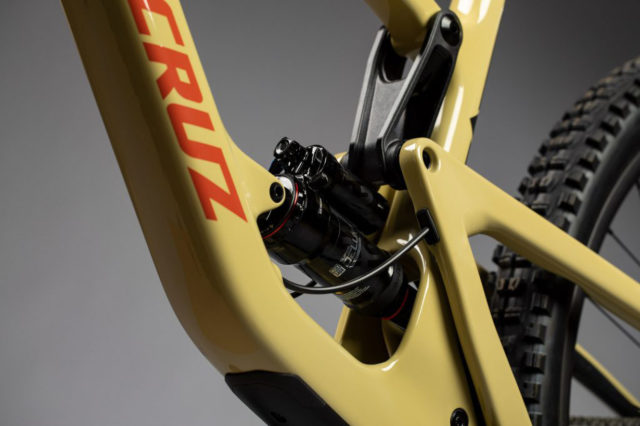
For reference, I’ve been running 30% sag in the Super Deluxe and 85 psi in the Lyrik. One thing worth noting about the Hightower’s linkage-driven shock is that, due to its placement in the frame, it is a huge pain to mess with when you are initially setting it up. Removing the shock or adjusting and monitoring your sag are impeded by the frame, which is a visibility and accessibility issue that will not be a problem once you figure out what you like. But it’s more difficult during initial setup vs. bikes with more accessible shocks.
Dylan: After spending time on both the v1 Hightower and Hightower LT, which both featured Santa Cruz’s upper-link-driven VPP suspension, I believe the lower-link-mounted shock layout is a big improvement. The main bulk of the weight and linkages being low and near the bottom bracket is a plus, but I think the biggest advantage is the more progressive leverage curve. I set up the rear shock to Santa Cruz’s recommended 160 psi for my weight, which equated to 30% sag, and the rear suspension immediately felt great. It offered adequate support throughout its travel, which helped maintain lots of traction both uphill and downhill, and the bike did a fairly good job of resisting bottoming out on those harsh g-outs and drops. Again, I’d prefer a volume spacer or two in the rear, but I think this is primarily due to my terrain preferences and riding style.
Climbing
Eric: On the way up, I’d say the Hightower is satisfactory for what it is. I rarely felt the need to flip the shock’s lever to firm up the suspension, which is a departure from previous Santa Cruz bikes I have ridden (where I found myself locking out the shocks constantly). At around 32 lbs and with slow-rolling Maxxis Minion DHR2 tires, the Megatower S / Carbon C is effective on the uphill, but it’s no rocket in its current form. Efficient cadence and strategic energy outputs got me quickly uphill, but it’s not a bike that effortlessly accelerates uphill at the first aggressive pedal stroke.
Overall though, the Hightower impressed me on the ascent with its efficient and straightforward manners, good traction, and room to move in the cockpit. But there are definitely some other bikes in this class that offer snappier climbing performance. The Ibis Ripmo, Trek Fuel EX, Pivot Mach 5.5, or Orbea Occam will feel more responsive when pointed uphill, especially when climbing out of the saddle. Personally, I felt much of this came down to the S / Carbon C build’s wheel and tire combo, and if you ran a lighter setup there, I think the Hightower would feel significantly quicker on the climbs.
Dylan: I agree here — the Hightower isn’t the most efficient or quickest ~140 mm Trail bike on the uphill. In its stock form, the Hightower S / Carbon C feels more oriented toward the descents. But I also did not feel the need to lock out the rear shock on anything but smooth roads, and pedal bob was not as bad as the v1 Hightower. If we look at anti-squat numbers for both versions, that seems to make sense: the v1 Hightower had about 101% anti-squat in the lowest climbing gear at 30% sag, while the v2 Hightower has about 110% anti-squat in the lowest climbing gear at 30% sag.
The Hightower wouldn’t be my first recommendation for riders specifically looking for a 29er in this class that climbs really well. Bikes like the Yeti SB130 T1 that are a bit lighter with faster-rolling rear tires can provide an easier way up than the Hightower in the Carbon C S Build, which can feel a bit sluggish at times. I think it’s safe to assume that the Hightower would feel quicker on the way up in the higher-end and lighter Carbon CC builds and / or with a more xc-oriented wheelset and tires. But that said, for those who aren’t in a rush to get to the top of their descents, the Hightower still compares pretty favorably to many of the ~140mm-travel bikes out there.
Jonathan: I generally like to think that people who sprint up climbs are just trying to make up for their deep feelings of insecurity and low self esteem. (At least, that’s how I try to justify my making them wait for me at the top of climbs.)
But if the Hightower isn’t the snappiest climber imaginable, I have to say that on steep switchbacks or techier climbs, I find it easy to keep the rear wheel planted and maintain traction. And depending on your riding style and the terrain you frequently ride, that could arguably make the Hightower “more efficient” if you mostly just need to keep your rear wheel gripping the trail and moving you forward. So to me, the Yeti SB130 definitely feels faster and / or more “efficient” on climbs in that it doesn’t create as much pedal bob during each crank. But I find myself losing the rear wheel less often on the Hightower.
Eric: I’d agree that the Hightower can be regarded as a quite “efficient” climber with respect to how well it maintains traction at the rear tire. Which is why Jonathan likes it on steep switchbacks and techy climbs. You use less energy to stay on line, and moving forward translates to efficiency. I think what we all are noticing is that the Hightower moves deeper into its shock’s travel / stroke, and so big / aggressive pedal strokes push it even deeper into its travel, making it “feel” a bit wallow-y but definitely grippy.
Descending
Eric: Overall, I found the Hightower to hold very true to its “Goldilocks” design intentions. With geo numbers almost identical to the Megatower but with a bit less travel, the Hightower is faster (no surprise) on the up, and I didn’t find myself going much slower when it was time to head down on all but the roughest trails. For many (myself included), this melding of modern geo numbers with a slightly more responsive ride (as a result of its more moderate amount of travel) is very appealing for a quiver-of-one bike. As would be expected with its pretty slack head angle, long wheelbase, low-ish BB, and 29” wheels, the Hightower has remained predictable and fast on just about anything I’ve encountered on the trail.
Two areas where I was impressed / caught off guard by the Hightower were its straightforward climbing manners and its ability to carry speed on descents.
A welcome aspect of the Hightower’s character is its generally improved feeling of rear-suspension compliance throughout its travel — most especially on sharp / square / large impacts — compared to the Megatower. The Megatower offers what I’d call a “powerful” ride (others might call it “harsh”), and it encourages proficient bikers to ride very, very fast.
The Hightower can still be ridden very fast, but it does a better job of smoothing out the more moderate sections of trail in almost all instances, except for the largest g-outs or impacts at race pace. Compared to the Megatower, the Hightower is much more comfortable at non-race speeds, making it much more enjoyable when you aren’t riding between the tape (i.e., many people’s “typical” day on their Trail bike).
Again, I think the more progressive leverage curve of the v2 Hightower’s rear suspension is at play here. At a broader range of speeds, and with almost any sort of on-trail feature, the Hightower felt very willing to just simply deal with what was in front of it. I felt like the Hightower had a better or more appropriate rebound tune (at least for my weight and ability) than the Megatower did, and this made the Hightower feel less harsh and more comfortable in a wider range of terrain and speeds.
The biggest “issue” I have with the Hightower on the descent came from that same ability to carry speed over rough trails. With the Hightower’s ability to build speed by pumping and working small trail features, its very stiff frame, and composed and capable suspension, on more than one occasion I found myself carrying too much heat into corners, and struggling to shed it in time to not blow up.
Part of this could be due to the fact that I spent more of my time on the Hightower on lower-traction trails. But when comparing it to the Megatower, it’s also in part due to the fact that the Hightower gives up its braking traction sooner than the Megatower because you are simply using up your available suspension sooner on the Hightower vs. the longer-travel Megatower. And yet, I was often carrying nearly identical — or sometimes even faster speeds — into corners on the Hightower. The grippy Maxxis Minion DHR2 was appreciated in these instances, and really, this isn’t a knock against the Hightower. I like that it’s so capable at speed that I need to pay more attention to my braking points. But it’s also worth noting that I did need to.
Dylan: Especially for a ~140mm-travel bike, the Hightower has impressed me on the descents. Its geometry numbers, combined with its more progressive suspension vs. old VPP bikes, create a stable and fairly forgiving ride on the way down. The Hightower does a great job handling chunky sections of trail and maintains plenty of traction, all without feeling particularly demanding.
At the same time, it was hard for me to find a scenario where the Hightower felt like “too much bike” — even on flatter, mellower trails, the Hightower felt responsive and sensible. Pumping over obstacles and popping off features was totally doable and it did a great job of carrying speed in these instances.
On the other hand, it was also hard to find the limits of the Hightower. I was able to push myself on some of the fastest, steepest descents in the Gunnison Valley without feeling like I didn’t have “enough bike” under me. The Hightower is one of the few cases where it actually felt like it could handle it all, and do so quite well.
I also spent a couple of rides on the Hightower on jump trails like Crested Butte’s Luge, Teaser, and Lower Avery. The Hightower is not difficult to get airborne, and riders who know how to jump a bike will not be disappointed in its ability to leave the ground. That being said, I wouldn’t necessarily categorize the Hightower as a super “poppy” or “playful” bike, as I think its more notable trait is how stable it feels (for a bike in this class) when heading down the fall line. Just know that the Hightower won’t hold you back if you enjoy bike-park-esque jump trails.
I also agree with Eric that the Hightower is able to smooth out the trail more effectively than the Megatower. As Eric noted, this makes sense when you think about the intended use of each bike. Since the Megatower is designed to be more of an EWS-race rig, it is meant to carry speed better through rock gardens and high-impact corners. The Hightower feels more forgiving and less speed-oriented in these situations, allowing you to be lazier and less game-on when it comes to line choice and body positioning, whereas the Megatower requires attentive, aggressive, and powerful riding. The Hightower is a much better choice for beginner to intermediate riders in this regard, and would be my suggestion over the Megatower for riders in that experience range looking to hop on a capable Santa Cruz 29er.
Jonathan: Did someone say “lazier” and “less game-on”? I’ll take it! While Eric and Dylan have both talked about how capable the Hightower is, I really want to underscore Dylan’s claims about how forgiving this bike feels. I’ve found the Hightower to be quite confidence-inspiring on lines that I haven’t ridden before where I am probably squeezing the brakes more than I’d like to admit.
So while Eric and Dylan have both talked about the capability of this bike at speed (and I’d agree), I’ve been equally or more impressed by how compliant this bike feels when I’m failing to maintain enough speed up technical climbs, or when I’m being overly cautious on rougher descents. In three words, I’d call this bike stable, confidence-inspiring, and forgiving — even at moderate and slower speeds.
2020 Hightower vs. 2019 Hightower vs. 2019 Hightower LT
Dylan: After spending a little more than a season on a Santa Cruz Hightower LT and about 4 rides on the previous v1 Hightower, the latest v2 Hightower outshines both bikes in terms of descending. With modern geometry that is slacker and longer than both bikes, the v2 Hightower provides a more stable platform, particularly on steep, rough trails.
As we’ve mentioned a few times now, both Eric and I enjoy the lower-link-driven VPP suspension as opposed to the upper-link-driven style that was used on both the v1 Hightower and Hightower LT. Riders who prefer a poppier, more lively bike on the way down might prefer the Hightower LT over the v2 Hightower, as I found the v2 Hightower felt more inclined to track on the ground while the Hightower LT was easier to get in the air.
As far as climbing goes, the v1 Hightower felt less inclined to sink into its travel and more efficient overall on the uphill than its successor, which I’d mostly chalk up to the two bikes’ different leverage curves and the fact that the original Hightower I rode was lighter, had 5 mm less travel in the rear, and 10 mm less in the front. Compared to the Hightower LT, the v2 Hightower has felt more efficient overall on the uphill.
Hightower vs. Yeti SB130
Dylan: One of the most similar bikes to the Hightower we’ve been spending time on is the Yeti SB130. Overall, the two bikes only differ by 10 mm in terms of rear travel, there are some slight differences in geometry, and of course, the Hightower’s lower-link-driven VPP rear suspension vs. Yeti’s Switch Infinity suspension design. It is worth noting that we reviewed the T1-build SB130 in Yeti’s Turq version of the frame (which would be more equivalent to Santa Cruz’s Carbon CC version) with some higher-end components.
But build kits aside, both bikes felt similar to me in terms of climbing ability. While the Yeti weighed less and had a faster-rolling rear tire, they both have about 110% anti-squat in the lowest climbing gear at 30% sag. In fact, the anti-squat curve for both bikes is strikingly similar, so I thought that the two’s pedaling performance throughout travel was very alike. (Jonathan also spent a lot of time riding these two bikes back-to-back, and he’s more inclined than I am to give the nod to the SB130 for being the faster, more efficient climber. But I’ll stick with my “strikingly similar” assessment.)
Where the bikes really differ is when the trail turns downhill. You can definitely notice the longer reach of the SB130 when descending. For me, this translated to the SB130 being slightly sluggish / cumbersome to get around tight corners while feeling a little more planted on rough sections of trail.
The suspension feels different, too — the Hightower has a considerably more progressive leverage ratio. On the trail, this equates to there being more bottom-out resistance with the Hightower, while I noticed that I tended to blow through the travel of the SB130 significantly more.
Overall, I’d say that the SB130 requires a bit more attentive and powerful riding style, while the Hightower would let you get away with more. While expert riders can certainly enjoy both bikes, I would suggest the Hightower out of the two for beginners to intermediate riders.
Jonathan: My two cents: The SB130 feels like more of a race bike. It’s less about providing a forgiving, plush feeling, and more designed to get you up and down the mountain as quickly as possible. So the more you’re interested in making good time on the way up, and the less you care about a more forgiving ride on the way down (or your trails are just smoother and faster), the SB130 is a great choice. But the Hightower’s capable and forgiving nature is really confidence inspiring.
Bottom Line
Eric: The Santa Cruz Hightower is an excellent example of what a true “all-rounder” should be. It’s fast, I found it to handle trail chatter more comfortably than you might expect of a mid-travel 29er, and it still offered the supportive suspension platform to deal with almost anything I might encounter at most any speed. But the Hightower still manages to pedal efficiently, is enjoyable when trails flatten out, and is quick and responsive enough to not need to be muscled around at all times.
In my opinion, the v2 Hightower’s revised rear-suspension linkage and more progressive leverage curve are overall major improvements over previous iterations of the VPP suspension platform. The v2 Hightower’s suspension package does a great job of keeping up with the capabilities of the Hightower’s geometry, the S / Carbon C build’s spec hasn’t let me down … the Hightower checks a lot of big boxes.
I think what I most enjoyed about the Hightower was being caught off guard by just how much speed I found myself carrying in places I didn’t expect to do so. And with a lighter parts spec, it’s pretty easy for me to imagine giving up a more Enduro-oriented, longer-travel bike in favor of something like that Hightower which has the geo I really like, the stiffness and support to be a weapon on the descents, but that’s a bit more fun when the trail is not EWS steep, or when my ride is going to be 40 miles long.
Dylan: The current Hightower is high on my list for one-bike-quiver picks. It does a bit of everything and it does it all quite well. It can get you to the top of your favorite descents and provides a forgiving and stable platform for the way down.
I believe the Hightower is a definite improvement over both the v1 Hightower and Hightower LT, thanks to its improved geometry and suspension kinematics. That being said, riders who appreciated the original Hightower for its climbing prowess may be slightly disappointed by the new Hightower, which is “fine” when going up, but really shines when going down. (And such riders might want to check out the Santa Cruz Tallboy.)
So if you feel a bit silly when hauling around your sluggish Enduro bike, you may find that the Hightower provides ample capability on the way down while being a better all-round choice for a wider range of trails. I believe the Hightower is also a better choice for beginner to intermediate riders over a bike like the Yeti SB130 or Santa Cruz Megatower, both of which require a more powerful, game-on approach.

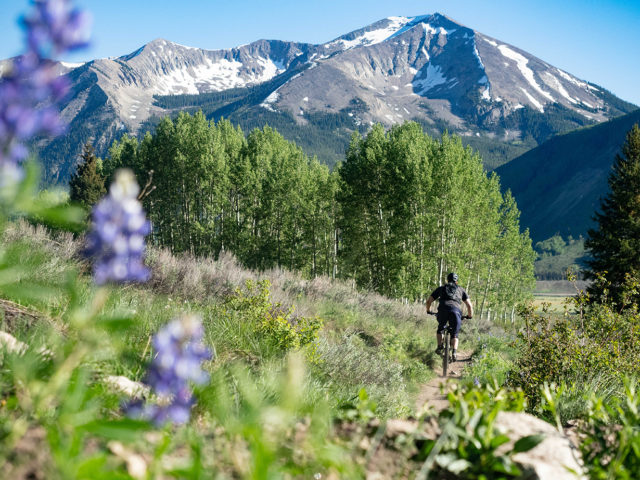

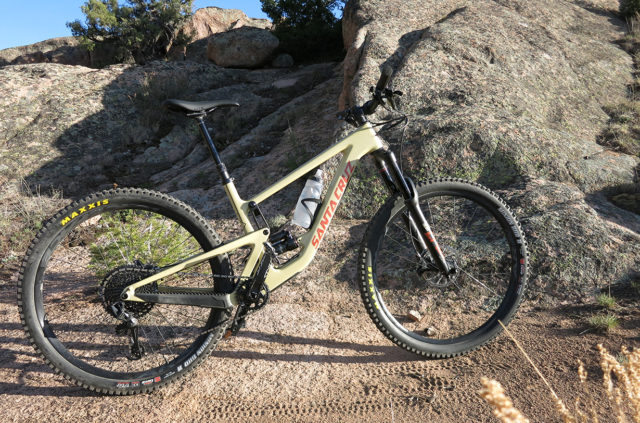

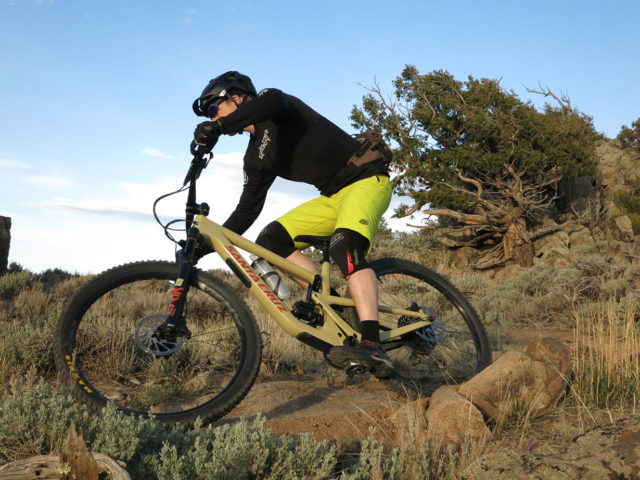
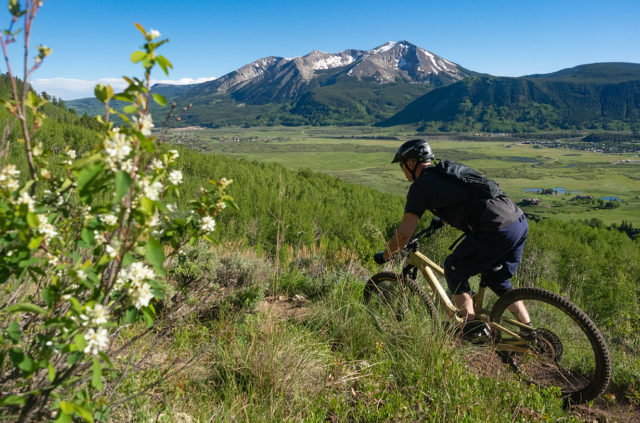
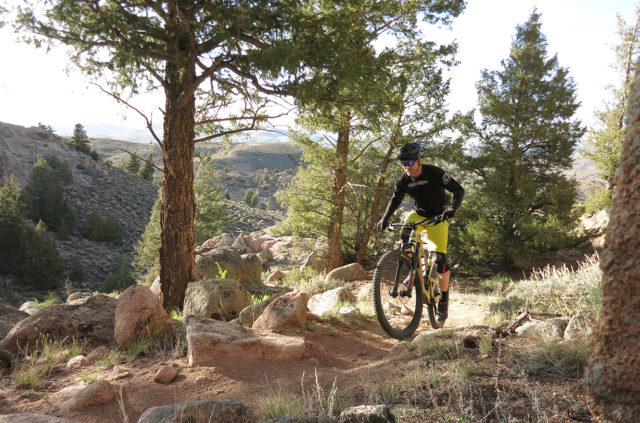
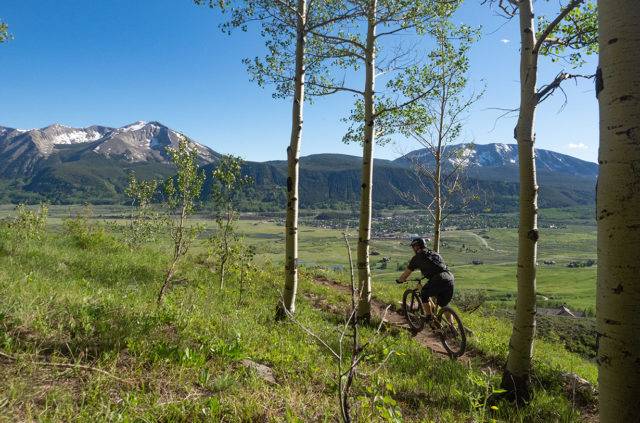

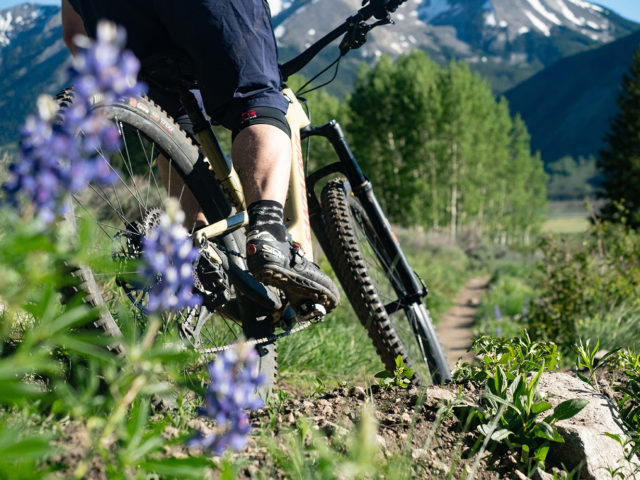
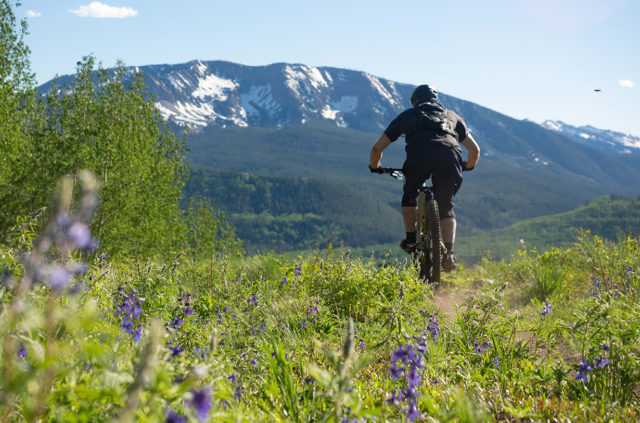
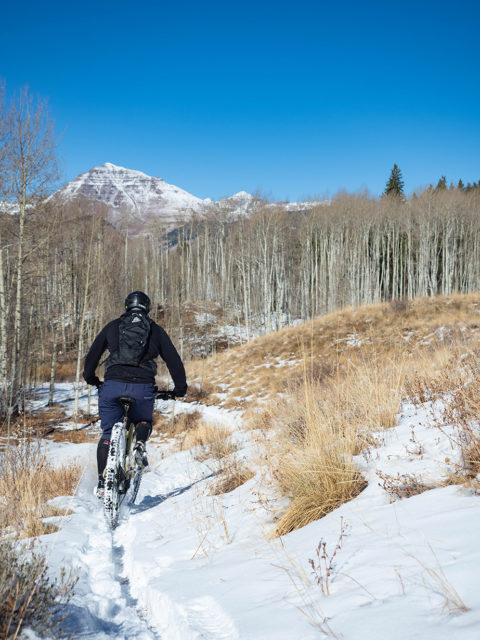


I challenge Blister to get a short and tall bike reviewer.
As a fairly tall rider, I am forced to ride (X)XL bikes due to fit. The opposite is true for short riders. We have some very good articles and reviews on the differences in ski sizes(lengths), let’s do the same for bikes.
Unlike skis, most people have no, or maybe one, choice in bike size. Also unlike skis, only the front center grows on most bikes.
Imagine if you reviewed skis and the 165 cm ski and the 190cm ski were both mounted 35cm from the tail?
I know it won’t be easy. But when was Blister ever about doing reviews the easy way?
How does this Hightower compare to the Smash? They’re very similar, travel, geo list, different carbon construction tho.
Have any of you ridden the new Pivot Switchblade and if so how does it compare?
Not yet, but some of our reviewers will be spending time on the new Switchblade later this summer so we’ll be able to compare the two later this year in the review of the Switchblade.
This would be super interesting. I’m shopping for a mid/aggressive trail bike and I’m considering the SC Hightower, Pivot Switchblade, Yeti SB130, and the Ibis Ripmo V2 XT w/ Factory suspension.
Great review. Thanks for mentioning the volume spacers. After several weeks on the same build Hightower, I found the rear shock in particular in serious need of progression. A couple spacers (from 1 to 3 total) made all the difference. This seems like a significant tuning/setup item that doesn’t get talked about enough… even to just know what is the factory setup (before you go and remove the shock).